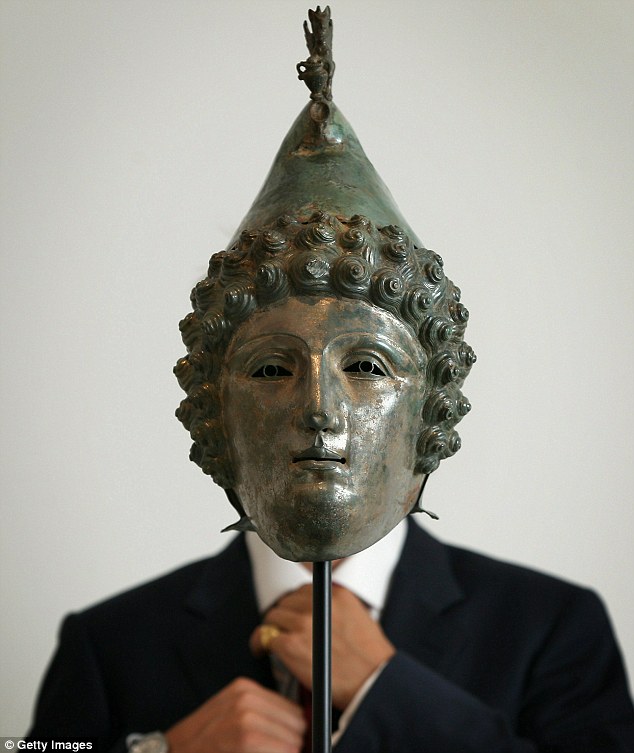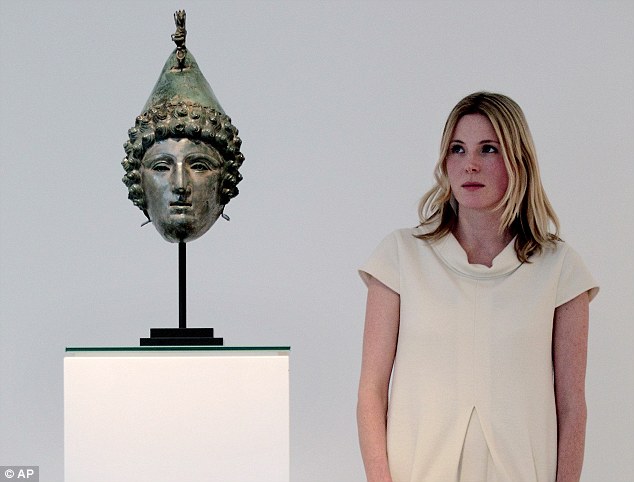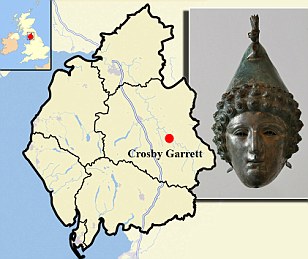A Roman bronze helmet complete with face-mask – thought to be one of only three of its kind to be found in Britain – has been discovered by a metal detector enthusiast in Cumbria.
The helmet, with its enigmatic and virtually intact features, would have been worn, possibly with colourful streamers attached to the object, as a mark of excellence by Roman soldiers at cavalry sport parades.
Described as a ‘hugely important discovery’, it is now expected to fetch £300,000 at Christie’s Antiquities auction in London.

A ‘hugely important discovery’: The Roman bronze helmet complete with face-mask was found at Crosby Garrett in Cumbria by a metal-detectorist
The Crosby Garrett Helmet – which dates from the 1st-2nd century AD – has been named after the hamlet in Cumbria where it was found in a field in May by the treasure hunter, who wants to remain anonymous.
The helmet has a never-seen-before griffin crest, which, with the object’s hair, would have been a golden bronze colour, contrasting with the polished white-metal surface of the face mask.
Christie’s described the find as an ‘extraordinary example of Roman metalwork at its zenith’.
The auction house’s London head of antiquities, Georgiana Aitken, said: ‘This helmet is the discovery of a lifetime for a metal detectorist.
‘When it was initially brought to Christie’s and I examined it at first-hand, I saw this extraordinary face from the past staring back at me and I could scarcely believe my eyes.

Enigmatic: The helmet would have been worn as a mark of excellence by Roman soldiers at cavalry parades

Under the hammer: Georgiana Aitken, the Head of Antiquities at Christie’s London, with the helmet
‘This is a hugely important discovery and we expect considerable interest at both the public preview and at the auction where it is sure to generate great excitement from museums and collectors alike.’
Arrian of Nicomedia, a Roman provincial governor under Hadrian, suggested, in an appendix to his military series Ars Tactica, that Romans wore the helmets as a mark of rank or excellence in horsemanship.
The Roman cavalrymen were divided into two teams that took turns to attack and defend during the events, which accompanied religious festivals and were also put on for the benefit of visiting officials.

Rare: It is one of only three of its kind discovered in Britain since records began 250 years ago

The mask is thought to have been worn with an elaborately painted shield, embroidered tunic, thigh-guards and greaves.
The helmet is one of only three of its kind discovered in Britain since records began 250 years ago.
The only other two helmets that have been discovered complete with face-masks are the Ribchester Helmet, found in 1796 and now in the British Museum, and the Newstead Helmet, found some time around 1905 and now at the Museum of Antiquities in Edinburgh.
The helmet will go on sale in the Antiquities auction at Christie’s South Kensington on October 7.





